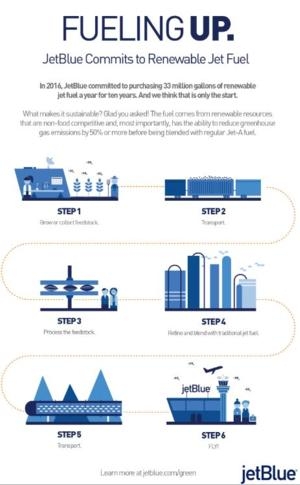The Deal Is One Of The Largest For Biofuel In Aviation History
JetBlue has announced a ten-year renewable jet fuel purchase agreement with SG Preston, a bioenergy company. The airline is partnering with SG Preston to purchase renewable jet fuel made from rapidly renewable, bio-based feedstocks that do not compete with food production. This marks one of the largest renewable jet fuel purchase agreements in aviation history, and the largest, long-term, binding commitment by any airline globally for HEFA (hydro-processed esters and fatty acids) based renewable jet fuel.

For nearly 100 years, planes have run on fossil fuels. Investments in renewable energy sources are key to a lower carbon future. Renewable jet fuel is produced from biological resources, like plant matter, which can be replenished rapidly and without impacting food supply. With SG Preston, JetBlue is creating renewable jet fuel that has the ability to benefit the airline’s bottom line while also lowering its net CO2 emissions.
Compared to traditional petroleum-based Jet-A fuel, renewable options can significantly reduce emissions, including pollutants related to air quality as well as net greenhouse gases. Renewable jet fuel is chemically equivalent to conventional Jet-A fuel, and poses no discernable difference in performance or safety.
“The future of aviation relies in part on renewable energy sources. We’re taking a leadership role in technology and other advancements including renewable jet fuels,” said Robin Hayes, president and chief executive officer, JetBlue. “JetBlue is preparing for a world where we must reduce our production of greenhouse gases. With this in mind, we have executed one of the largest renewable jet fuel purchase agreements. This is just one step of many in our work towards a lower carbon future.”
JetBlue is taking a long-term approach, evaluating various technologies, materials and feedstocks. To launch the strategic relationship with SG Preston, JetBlue plans to purchase more than 33 million gallons of blended jet fuel per year for at least 10 years. The fuel will consist of 30 percent renewable jet fuel blended with 70 percent traditional Jet-A fuel. The renewable jet fuel portion produced from select plant oils is targeted to achieve a 50% or higher reduction in greenhouse gases emissions per gallon based on a life-cycle analysis. The fuel is expected to meet the Environmental Protection Agency’s (EPA) qualification for renewable fuel standards, as well as the Roundtable on Sustainable Biomaterials certification standard for sustainable production of biofuels.
JetBlue is currently progressing forward and working through the process with the intent of supplying New York-metropolitan area airports with renewable jet fuel. In its blended form, the total amount of renewable jet fuel JetBlue will purchase equals approximately 20 percent of its annual fuel consumption at New York John F. Kennedy International Airport (JFK).
“This strategic relationship with JetBlue is a continuation of SG Preston’s commitment to develop reliable products from renewable resources at commercial scale and volume for stakeholders who recognize renewable has transcended buzzword status and is a critical component of responsible growth,” said Randy Delbert LeTang, SG Preston founder, chief executive officer and president. “Our strategy is to address the demand versus supply gaps in the industry and align development and delivery mechanisms to meet our customers’ demand in the least disruptive way.”

With an aviation industry-wide goal to cap net greenhouse gas growth from 2020 onward, renewable jet fuel is a key aspect of JetBlue’s emissions reduction strategy. The Federal Aviation Administration (FAA) has approved renewable jet fuel safe for use. JetBlue business partners have tested the type of renewable jet fuel associated with this deal and qualified it for use in 2011 via industry evaluations that took place as part of the alternative fuels approval process of ASTM International, the standard-setting body for fuels used by the aviation enterprise. To date, more than 2,200 commercial, revenue flights by 22 airlines have flown on different types of renewable jet fuel, with many of those flights being flown with the HEFA-SPK type fuel to be produced by SG Preston.
“This is a first of many steps towards a slowly evolving change. With our partner, SG Preston, we are pursuing renewable jet fuel production from feedstock systems with the ability to lower CO2 emissions by 50 percent or more per gallon before blending. This is a proactive step to address customer demand and protect our business and the future of our industry,” said Hayes.
“With this announcement, U.S. airlines continue to lead the way to a more secure and environmentally friendly future,” said A4A’s Vice President, Environmental Affairs Nancy Young. “Sustainable alternative aviation fuels help our members build on their already strong environmental record and help reduce price volatility and enhance energy security by providing a competitor to petroleum-based jet fuel.”
In 2016, JetBlue began actively exploring the ability to purchase renewable jet fuel for commercial use. In 2015, JetBlue was the only airline to sign the White House’s American Business Act on Climate Pledge, highlighting its support for an international climate agreement toward a low-carbon future. JetBlue pledged to reduce global emissions from commercial air travel in partnership with aircraft and engine manufacturers, the FAA, and others.
(Image provided with JetBlue news release. Nancy Young quote provided by A4A)
 Airbus Racer Helicopter Demonstrator First Flight Part of Clean Sky 2 Initiative
Airbus Racer Helicopter Demonstrator First Flight Part of Clean Sky 2 Initiative Diamond's Electric DA40 Finds Fans at Dübendorf
Diamond's Electric DA40 Finds Fans at Dübendorf ANN's Daily Aero-Term (04.23.24): Line Up And Wait (LUAW)
ANN's Daily Aero-Term (04.23.24): Line Up And Wait (LUAW) NTSB Final Report: Extra Flugzeugbau GMBH EA300/L
NTSB Final Report: Extra Flugzeugbau GMBH EA300/L Classic Aero-TV: 'Never Give Up' - Advice From Two of FedEx's Female Captains
Classic Aero-TV: 'Never Give Up' - Advice From Two of FedEx's Female Captains




